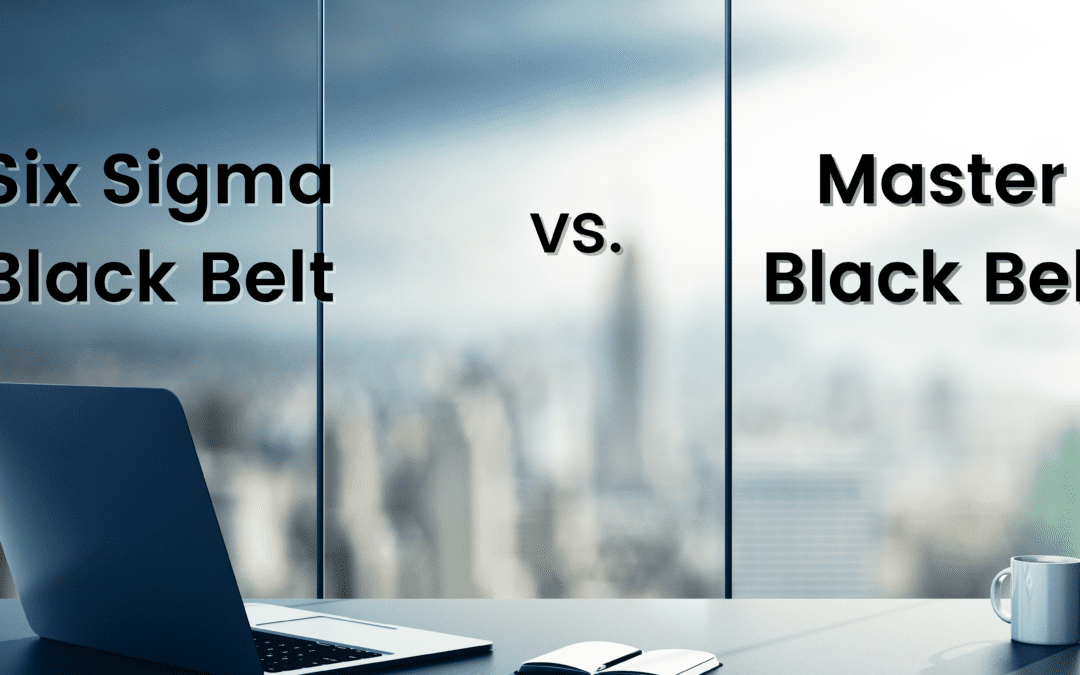Table of contents
Six Sigma Black Belt vs. Master Black Belt
The Six Sigma black belt and master black belt in definition are the highest two belt degrees. Both denote Lean Six Sigma mastery. However, there are many differences between them (Six Sigma Black Belt vs. Master Black Belt). Before we can learn more about black belt masters and black belts, let’s first understand what they are.
Lean Six Sigma, a data-driven methodology, encourages continual process improvement through focusing on flaws and inconsistencies as well as waste elimination. Lean Six Sigma is assessed using a well-established belt system.
Six Sigma belt classification is based on martial arts rankings. Each color indicates the level of Six Sigma knowledge, tactics, tools and methods. These are the three initial belt levels.
White: Individuals learn the basics of white terminology and most common procedures.
Yellow: This section includes jargon, techniques and procedures training. Six Sigma project participation may be restricted to yellow belt holders.
Green: Individuals experience significant growth as they gain more experience and learn how key roles are played in Six Sigma projects under the guidance of a Six Sigma blackbelt leader.
Master Black Belts and Black Belts Hold Key Positions in Lean Six Sigma Development and Implementation
Lean Six Sigma, a data-driven methodology, promotes continuous process improvement and a focus on eliminating variation, defects, and waste. A long-standing belt system is used to measure proficiency in Lean Six Sigma.
Black Belt and Master Black Belt are the final two levels of belt. Both designations signify mastery in Lean Six Sigma. However, there are significant differences between them.
What is the Six Sigma Black Belt and what does it mean?
Six Sigma is a method that reduces waste. The principal goal of the Lean method is to minimize wastage. Lean Six Sigma (LSS), a discipline that combines both of these methodologies, is Lean Six Sigma. Lean analysis identifies eight wastes and recommends improvements to manufacturing operations that can be used to manage and minimize waste. By paying attention to the impact of waste on manufacturing processes, business executives can optimize their operations and make substantial progress in optimizing them.
Black belt candidates learn how to bring about meaningful change within an organization. Participants can participate in improvement projects as part of the certification program. This gives them the management experience they need to manage their own businesses and help supervise lower-level belts.
To improve your skills and use your knowledge efficiently to help businesses and organizations in their organizational processes, you can get your Lean 6 Sigma Black Belt certification

The Duties of a Six Sigma Black Belt
Any Six Sigma black belt certified person should be able to manage, design, develop and manage projects and create new products and services using the DMADV approach. Black belts and master black belts train the lower-level belts. Master black belts teach the trainees exactly what they need to know. Black belts and Master black belts ensure that their trainees are well-informed.
Black belts are responsible for implementing and completing the projects and plans they have been given. They interact with different groups and train others to become team leaders. Black belts must have exceptional leadership skills and experience in psychology and human behavior.
Black belts are also able to act as consultants within an organization, supporting multiple departments at once. They can also help with problem-solving or statistical lectures. Green belt and black belt master black belts mentor applicants. Black belts must have exceptional communication skills to lead their teams. They will be able to teach Six Sigma and create teams that deliver exceptional results. The green belts will be there to assist the black belts when they aren’t leading their teams.
What is the Six Sigma Master Black Belt and what does it mean?
Six Sigma Master Black Belt is the highest level of Six Sigma certification. Master black belts are skilled in complex business processes and can execute specialized programs in micro- and macro-organizations. They also have the ability to quickly transition between business areas. The Six Sigma methodology is taught to Black, Green, and Yellow belts by master black belts. They also coordinate Six Sigma projects within the company. Their organizational duties, knowledge, and operations are the main differences between the master black belt and six sigma black. This article will continue to discuss the responsibilities and duties of master black belts vs. black belts.
Duties for a Six Sigma Master Black Belt
Master black belts are responsible for formulating and delivering an organization’s Six Sigma plan. The ultimate goal of Six Sigma is to improve output and reduce costs. They work with the company’s leaders and other stakeholders in order to establish clear objectives and then guide the Six Sigma team towards achieving them. The master black belt is the one who paves the way to others in the Six Sigma group.
Master black belts solve problems, analyze data, and design projects to improve an organization’s Six Sigma processes. The master black belt mentors the Six Sigma team and ensures that the project is completed on schedule.
Six Sigma master black belts must be able to lead. Because the job involves significant organizational transformation, master black belts must be able to communicate effectively with their team. Six Sigma teams often include green belts and yellow belts as well as black belts from different levels of Six Sigma. The master black belt starts a program. The black belts supervise and support the yellow and green belts who are project managers. The master black belt educates the group using their knowledge and experience.
Master black belt tasks are often complex and detailed. Each step must be completed correctly in order to allow for error. They are responsible for creating and implementing programs that can be used by the rest of their team. They should also be available to help black belts in any way they need. The master black belt’s job is to establish a solid management system.
Differences between Master Black Belt and Black Belt

Below are the key differences between black belt and master black belt.
An Organization’s Order
The Six Sigma Belt hierarchy’s highest rank, the master belt, is it. The Six Sigma master belt is just below the black belt in the Six Sigma belt hierarchy.
Major Roles
The Six Sigma Master Black Belt in definition coaches and trains the black and green belts. They are at the Six Sigma program’s level. They are responsible for leading the organization’s problem-solving efforts. They coach and train the team members below them.
Major Responsibilities
Six Sigma Master Black Belt:
- Six Sigma master belts help to build Six Sigma approaches and strategies in organizations.
- The Six Sigma master belt organizes this project.
- Mentoring teams is possible through the Six Sigma master belt.
- Six Sigma master belt ensures that you reap the benefits of Six Sigma.
- A Six Sigma master belt, like the black belts helps to remove obstacles and ensures that the project is executed accurately.
Six Sigma Black Belt:
- The Six Sigma black belt creates a Six Sigma framework for the given process/area and a rollout strategy.
- Six Sigma black belt completes the projects.
- The Six Sigma black belt guides and assists the team.
- Six Sigma black belt guides and assists with project material.
- Six Sigma Black Belt helps with the removal of project-level obstacles.
- Six Sigma Black Belt assists in the organization of the team and projects.
- Mentors for the green belts at lower levels of Six Sigma Black Belts are Six Sigma black belts.
- Six Sigma black belt continues sharing the best practices.
Self-Career and Organizational Benefits
Six Sigma Master Black Belt:
- Six Sigma culture is established in an organization by master black belts.
- Black belts benefit from the mentorship and statistical skills of master black belts.
- Six Sigma Master black belts who have acquired in definition the knowledge and skills in Six Sigma can move up the career ladder to become Chief Quality Officers.
Six Sigma Black Belt:
- Black belts can improve the efficiency of an organization’s operations.
- Black belts are trained in Six Sigma technology and statistical analysis to enhance organizational results. They have many job options, including those who are business analysts or process improvement specialists.



















